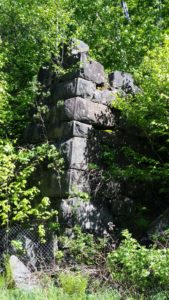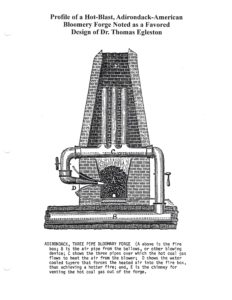Andebit et beaqui corendit, ut quostes esciendion re dit ad et prae parion es quia quas alibus sam, omnim faciden ducipidiat arum autem nobis enis es voat

11. Colburn Blast Furnace
Bloomery Forge Versus Blast Furnace
Listen to the Site 11 Iron Story Narration

Bloomery smelting was a major factor in the regional economy of the Adirondacks through the 19th century. Production reached a peak in 1882 when over 48,000 tons of bloomery iron was made. The advantage of bloomery smelting is that the iron ore is reduced directly to solid iron with charcoal fuel in a hearth that is small enough to be worked by one person. At an Adirondack forge, 2,000 pounds of iron could be made from 4,000 pounds of ore and 5,400 pounds of charcoal with just 1.25 man-days of labor. These numbers were far more efficient than any of the most sophisticated bloomeries of Europe. The technical superiority of Adirondack bloomeries came from improvements in the process before 1850. One of the most important was the use of a hot blast to improve the fuel efficiency of the process. Blast furnaces could make more iron in far less time. A brick stack over the hearth contained the pipes for pre-heating the air supplied to the tuyere (a pipe, through which air is blown into hearth) with waste heat that would otherwise be lost up the forge stack. Since hot blast resulted in considerable savings in fuel costs with no noticeable change in the quality of iron made, it would have been difficult for cold blast forge to stay in business once the hot-blast method was common.In contrast, a blast furnace is much more expensive to build. It requires a huge, brick-lined stack, where iron ore, coke, and limestone are dumped into the top, and preheated air is blown into the bottom. The raw materials to descend to the bottom of the furnace where they become the final product of liquid slag and liquid iron. These liquid products are drained from the furnace at regular intervals. The hot air that was blown into the bottom of the furnace ascends to the top after going through numerous chemical reactions. Once a blast furnace is started, to be practical, it had to be kept in continuous operation, 24 hours a day for lengthy periods.

All in all, bloomeries were a better fit for the Adirondack region. The very last bloomery forge operating in the entire United States was the one at Standish, NY—near the mining center at Lyon Mountain in the Adirondacks and 65 miles northwest of Mineville. It ceased operations in 1904—shortly following a New York Times editorial blasting the massive deforestation across the Adirondacks. While it may have been in part political, the decision to shutter Lyon Mountain may have also been due to the fact that there simply was little local charcoal left to power the forge.
One of the few stone blast furnaces left to see in Essex County is the Colburn furnace, west of Moriah Center. It is largely in ruins, however. Built in 1848, it was likely very short-lived. There was no running water supply in the area and so it was powered by a 40-horsepower steam engine. At the time, the only other steam-powered furnace in the area was the one at Fletcherville—it was around this time that furnaces were slowly transitioning from water to steam power. (At both Colburn and Fletcherville, charcoal powered the engine.) Once standing 40 feet tall, it has collapsed into heaps of stone and iron fastenings. The stone blast furnace was a pyramid-shaped structure with an inner cavity.
Colburn furnace worked primarily Sanford Ore Bed iron, mined two miles away in Mineville. One ton of iron ore processed through the furnace required 170 bushels of charcoal. The value of the pig iron at the lakeshore would be about $20 per ton. Little information is available about who built this furnace, how much iron was processed through it, and where the pig iron produced was sent.
Travel Tools
Turn left on the North Hudson Road. Just at the intersection with Furnace Road, you’ll see a small pull off on your right. The furnace remains are across the street about a tenth of a mile east (at 44.055576,-73.5288151). You can see the remains, which are on private property, from the road.


